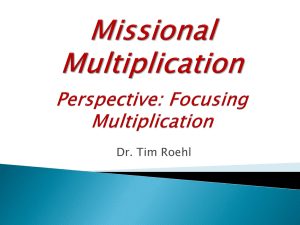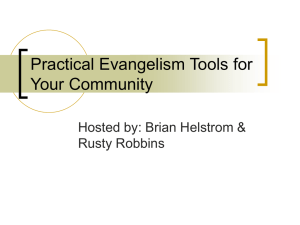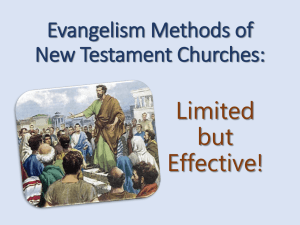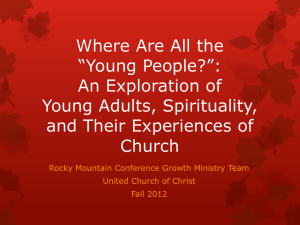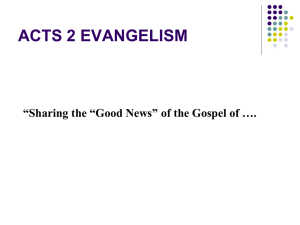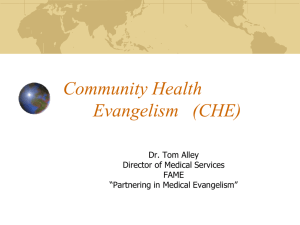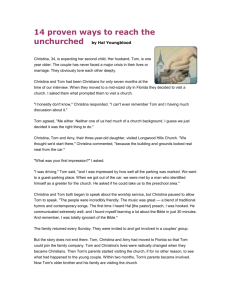Church Growth through Outward Focused Children`s Ministry
advertisement
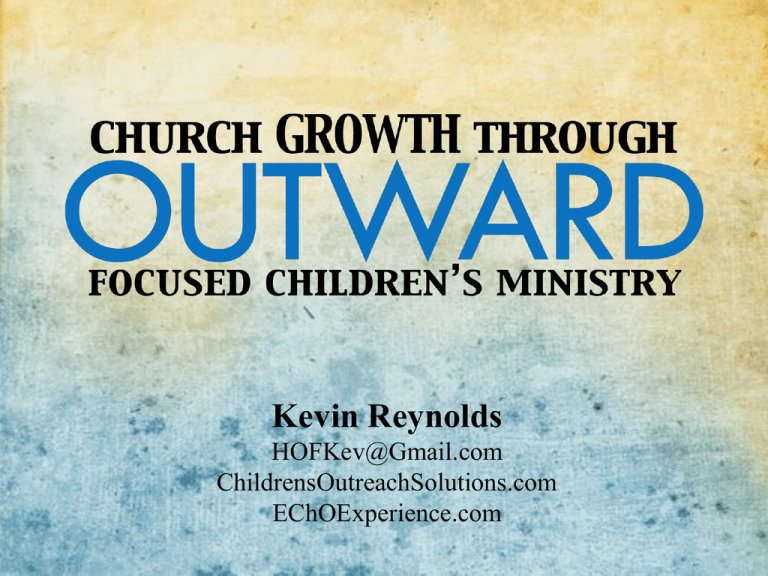
Kevin Reynolds HOFKev@Gmail.com ChildrensOutreachSolutions.com EChOExperience.com "The most effective community prevention program that our local Juvenile Justice system has!" Mark Williams – Chief Juvenile Probation Officer, Tom Green Co. TX Church/School Adoptions Kenya Guatemala Mexico Singapore Peru Canada Russia Bulgaria India Mongolia New Zealand China Kevin Reynolds ChildrensOutreachSolutions.com EChOExperience.com Effective Neighborhood Outreach • ef·fec·tive –adjective • 1.adequate to accomplish a purpose; producing the intended or expected result: 2.actually in operation or in force; functioning: • neigh·bor·hood –noun • 2.a district or locality, often with reference to its character or inhabitants: • out·reach –verb (used with object) • 1.to reach beyond; exceed: 2.to reach out; extend. 3.to reach out. 4.an act or instance of reaching out. 5.length or extent of reach. 6.the act of extending services, benefits, etc., to a wider section of the population, as in community work. George Barna of The Barna Group George Barna says, "The research is very clear: if Jesus is not already part of their lives by the time they leave junior high school, the chances of them accepting Him as their Lord and Savior are very slim (6%, to be exact). With children, it is just the opposite. Because of the challenges and insecurities they face in life, they are very open to being a part of a community of like-minded people who grow together. Children have a tremendous influence within their families and on the choices they make in all areas of life...The greatest evangelical window currently available is among young children." George Barna says, "The research is very clear: if Jesus is not already part of their lives by the time they leave junior high school, the chances of them accepting Him as their Lord and Savior are very slim (6%, to be exact). With children, it is just the opposite. Because of the challenges and insecurities they face in life, they are very open to being a part of a community of like-minded people who grow together. Children have a tremendous influence within their families and on the choices they make in all areas of life...The greatest EVANGELICAL window currently available is among young children." Reaching the Unreached in Your Community By the age of nine, most of the moral and spiritual foundations of a child are in place - Barna Reaching the Unreached in Your Community The probability of becoming a Christian for kids ages 5–12 is 32%... Teens 13-18 yrs, 4%... Adults 19 & up, 6% - Barna Reaching the Unreached in Your Community Worldwide, 85% of those receiving Christ do so between the ages of 4 and 14. - Larry Sharp, Children in Crisis, p. 249 Reaching the Unreached in Your Community Definition of unchurhced: Someone who is 18 or older and has not attended a Christian Church service in the last six months. * 1 of 3 adults = 33% George Barna Surprising Insights from the Unchurched Thom S. Rainer Reaching the Unreached in Your Community Myth #1) Most unchurched think and act like Anglo, middle-class suburbanites with no church background. No, the unchurched are not a monolithic group. Surprising Insights from the Unchurched – Thom S. Rainer Reaching the Unreached in Your Community Myth #6) We must be careful in our teaching and preaching so that we do not communicate deep and complex Biblical truths that will confuse the unchurched. Not so. Story: LJ and dad in prison – choices now affect – Cycle Breaker Surprising Insights from the Unchurched – Thom S. Rainer Reaching the Unreached in Your Community Myth #9) The unchurched are concerned only about their needs. 1 out of 3 returned to meet their children’s needs. Surprising Insights from the Unchurched – Thom S. Rainer Reaching the Unreached in Your Community Fifteen Lessons from the leaders whose churches reach the unchurched #11) Focus evangelistic efforts on children and youth. * 81% accept Christ before age 20 Surprising Insights from the Unchurched – Thom S. Rainer The Challenge of the Great Commission Thom S. Rainer The Challenge of the Great Commission In a section called The ten Surprises About the Unchurched – Thom S. Rainer Surprise #10) Many of the unchurched are far more concerned about the spiritual well being of their children than themselves. Dynamics & Issues That Contribute to Continual Growth with Tom Cheyney Sited Resources • www.ChurchPlantingVillage.net • www.NAMB.net/CMR • www.barna.com • Nine Habits of Effective Churches – George Barna • Comeback Churches – Ed Stetzer • Eleven Innovations for Growing Churches – Elmer Towns Five Practices of Fruitful Congregations 1. Radical hospitality – the active desire to bring people to Christ and his church 2. Passionate worship – fresh encounters with God that transform lives 3. Intentional faith development – learning together in community 4. Risk-taking mission and service – an outward focus that changes the world through missional activity while invigorating the church 5. Extravagant generosity – sharing that exceeds all expectations Habits that are beneficial to Effective Best Practices! • To avoid creating bad habits in ministry we must be very conscious of what we do, when we do it, why we do it and the outcome of those actions. Here are four elements that make a habit desirable and not negative: 4. It is a biblical behavior. Everything must be examined in light of God’s principles and parameters. Habits that are beneficial to Effective Best Practices! • To avoid creating bad habits in ministry we must be very conscious of what we do, when we do it, why we do it and the outcome of those actions. Here are four elements that make a habit desirable and not negative: 1. It is a intentional behavior. (Anything unintentional pulls away from the experience!) Habits that are beneficial to Effective Best Practices! • To avoid creating bad habits in ministry we must be very conscious of what we do, when we do it, why we do it and the outcome of those actions. Here are four elements that make a habit desirable and not negative: 2. It is a strategic behavior. There is purpose behind the action. It is consistent with the mission, vision, and values. Habits that are beneficial to Effective Best Practices! • To avoid creating bad habits in ministry we must be very conscious of what we do, when we do it, why we do it and the outcome of those actions. Here are four elements that make a habit desirable and not negative: 3. It is a productive behavior. The goal is changed lives. Anything less needs to be removed. Strategic Prayer Strategic Prayer was listed as one of the top three factors for church revitalization and I would add for new church growth as well (other two were Evangelism and Preaching). Forty-four percent of respondents say that the key ingredient in growth is strategic prayer. Prayer changes things! It is a learned behavior. No one masters prayer and there are no experts. An increased emphasis in prayer and our prayer patterns in a church is vital. Pg 200, 55 Stetzer Engaging in Strategic Evangelism Four out of five protestant churches describe their church as evangelistic! The difference for highly effective evangelistic churches is that they are engaged strategically in evangelism. • It is an act of love not a pressure to accomplish sort of thing. • A large focus on Child & Youth evangelism. (These ministers are perhaps the primary evangelist of the church!) • These finish the task by completing the evangelization process through personal discipleship of new converts! Pg 103 Barna Habits 1. 2. 3. 4. Highly effective churches rely upon strategic leadership. Highly effective churches are organized to facilitate highly effective ministry. Highly effective churches emphasize developing significant relationships within the congregation. Highly effective churches invest themselves in genuine worship. 5. Highly effective churches engage in strategic evangelism. 6. 7. 8. 9. Highly effective churches get their people involved in systematic theological growth. Highly effective churches utilize holistic stewardship practices. Highly effective churches serve the needy people in their community. Highly effective churches equip families to minister to themselves. When surveyed, the most frequent answer to the question “Why do churches exist?” was to demonstrate the love of God by helping the needy. But one in ten churches are actually engaged in community while one if five pastors believe they are engaged. There is a balanced to strike for sure but all of us could do more than we are doing. Question: How are we (the American Church) doing with all this flood of information? The American Church in Crisis David Olson The church in Arizona grew in attendance by 1.4% each year from 2000 to 2005, while the general population grew by 3% each year. The church in Arizona grew in attendance by 1.4% each year from 2000 to 2005, while the general population grew by 3% each year. During that five-year period, 22,000 additional children and teenagers began to attend church regularly. The church in Arizona grew in attendance by 1.4% each year from 2000 to 2005, while the general population grew by 3% each year. During that five-year period, 22,000 additional children and teenagers began to attend church regularly. Yet from 2000 to 2005, the under 18 population of Arizona grew by 207,000. The church in Arizona grew in attendance by 1.4% each year from 2000 to 2005, while the general population grew by 3% each year. During that five-year period, 22,000 additional children and teenagers began to attend church regularly. Yet from 2000 to 2005, the under 18 population of Arizona grew by 207,000. In the short span of five years, 185,000 children and youth were born in or moved to Arizona who had no consistent connection to a church. JOSHUA Son of Nun “After that whole generation had been gathered to their fathers, another generation grew up, who knew neither the LORD nor what he had done for Israel.” Judges 2:10-11 NIV Two Articles: 1. The Importance of Children’s Ministry White Hutchinson Group 2. Evangelism is Most Effective Among Kids – The Barna Group There are nearly 100 million unchurched people in the U.S. Do you know how to connect with them in ways that will lead to faith-based life transformation? More than 80% of the current growth registered by Protestant churches is biological or transfer growth – very little of the growth comes from penetrating the ranks of the unchurched. Building Blocks of Church Growth through Outward Focused Children’s Ministry 1. Intentional FOCUS on Child Evangelism - This requires Buy-In -Leadership -Church body - Program Priority -Budget (used Brian as an example) -Schedule - Mission or Family emphasis in organizational structure Building Blocks of Church Growth through Outward Focused Children’s Ministry 1. Intentional FOCUS on Child Evangelism 2. Facilitate “The Rachel Factor” - A Bridge Builder - Incarnational -Jesus model – Philippians 2 Building Blocks of Church Growth through Outward Focused Children’s Ministry 1. Intentional FOCUS on Child Evangelism 2. Facilitate “The Rachel Factor” 3. Lifestyle vs Event mentality - Ongoing regular part of the overall life of the church as opposed to sporadic events … VBS questions. Guy named Ron – 80 kids, 50 in target group, 10 came next week, none 6 months later ….used Jennifer Griffin in Las Vegas as an example – Joe’s idea using last day of VBS as a blitz – or- using VBS as a weeklong blitz Building Blocks of Church Growth through Outward Focused Children’s Ministry 1. 2. 3. 4. Intentional FOCUS on Child Evangelism Facilitate “The Rachel Factor” Lifestyle vs Event mentality Early opportunity for family involvement - Parents want to take an active role …used Ron again – gave example of how he could incorporate parents in, like maybe signing them up for help on the Friday/last day blitz/as they drop their kids off for VBS … also brought up welfare mentality Building Blocks of Church Growth through Outward Focused Children’s Ministry 1. 2. 3. 4. 5. Intentional FOCUS on Child Evangelism Facilitate “The Rachel Factor” Lifestyle vs Event mentality Early opportunity for family involvement Varied initial connection points - More often than not these are … Building Blocks of Church Growth through Outward Focused Children’s Ministry 1. 2. 3. 4. 5. Intentional FOCUS on Child Evangelism Facilitate “The Rachel Factor” Lifestyle vs Event mentality Early opportunity for family involvement Varied initial connection points - More often than not these are … NOT AT YOUR CHURCH!!!!!!!! Kevin Reynolds ChildrensOutreachSolutions.com EChOExperience.com Top 10 most effective models of Outreach 1. 2. 3. 4. 5. Intentional FOCUS on Child Evangelism Facilitate “The Rachel Factor” Lifestyle vs Event mentality Early opportunity for family involvement Varied initial connection points Play Time ..\..\..\..\..\..\..\Pictures\Photos\HOF\Bradford BBC\DSCF4294.JPG Play Time ..\..\..\..\..\..\..\Pictures\Photos\HOF\Bradford BBC\DSCF4294.JPG Play Time Getting Started Getting Started Game Time Game Time Start With Prayer Start With Prayer Opening Scripture / Life Point Scripture / Life Point Scripture / Life Point Positive Motivation Activities

